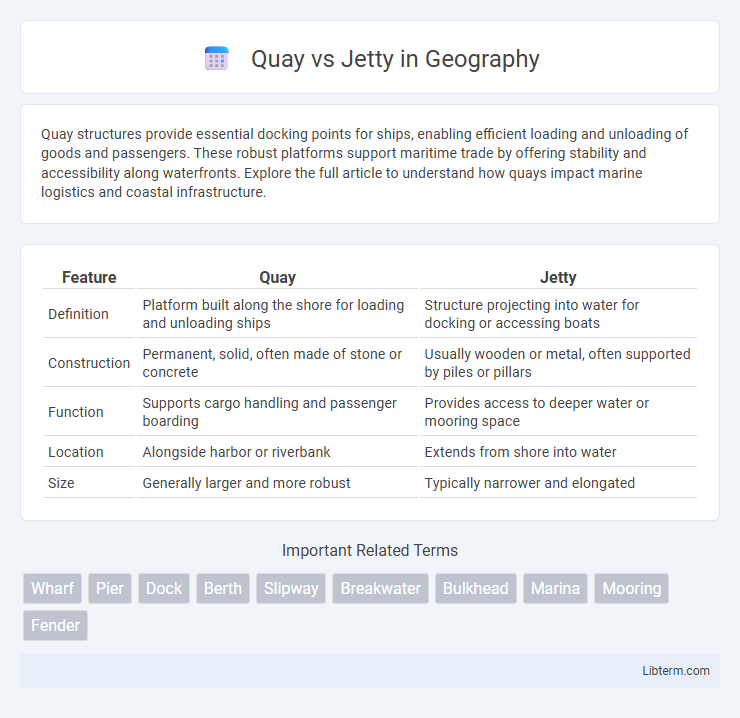Quay structures provide essential docking points for ships, enabling efficient loading and unloading of goods and passengers. These robust platforms support maritime trade by offering stability and accessibility along waterfronts. Explore the full article to understand how quays impact marine logistics and coastal infrastructure.
Table of Comparison
| Feature | Quay | Jetty |
|---|---|---|
| Definition | Platform built along the shore for loading and unloading ships | Structure projecting into water for docking or accessing boats |
| Construction | Permanent, solid, often made of stone or concrete | Usually wooden or metal, often supported by piles or pillars |
| Function | Supports cargo handling and passenger boarding | Provides access to deeper water or mooring space |
| Location | Alongside harbor or riverbank | Extends from shore into water |
| Size | Generally larger and more robust | Typically narrower and elongated |
Introduction to Quay and Jetty
A quay is a solid, stationary structure built along the shore for loading and unloading ships, typically made of concrete or stone, designed to handle heavy cargo and passenger traffic. A jetty, on the other hand, is a narrow, often elongated structure extending into a body of water, primarily used to influence currents, protect harbors, or support piers and docks. Both serve essential roles in maritime infrastructure, facilitating safe mooring and efficient transfer of goods and passengers.
Defining Quay: Structure and Function
A quay is a solid, fixed structure built along the edge of a harbor or river, designed for mooring vessels and facilitating the loading and unloading of cargo. Unlike a jetty, which primarily acts as a breakwater or extends into the water for protection, a quay serves as a stable platform directly adjacent to the shore, often constructed from concrete, stone, or steel. Quays are integral to port infrastructure, supporting heavy goods handling and providing access for transportation logistics.
Understanding Jetty: Structure and Usage
A jetty is a sturdy structure extending from the shore into a body of water, primarily designed to protect harbors, control currents, and prevent sediment buildup. Constructed using materials like timber, stone, or concrete, jetties facilitate safe navigation by stabilizing channels and reducing erosion along coastlines. Commonly found near river mouths or estuaries, jetties support maritime activities such as fishing, docking, and vessel mooring by providing secure, accessible points along waterways.
Key Differences Between Quay and Jetty
A quay is a solid, stationary structure built along the shore or riverbank, designed to facilitate the loading and unloading of ships, often made of concrete or stone, providing a stable platform for cargo handling. A jetty is typically a narrow, often movable, pier or walkway that extends into the water to protect the shoreline, control currents, or serve as a docking area for small boats. The key difference lies in the quay's primary function as a cargo handling and mooring structure, whereas a jetty primarily serves to manage water flow and provide limited docking, with variations in construction and usage depending on the maritime environment.
Construction Materials and Methods
Quays are typically constructed using reinforced concrete, stone, or steel sheet piles to create durable, load-bearing structures designed for heavy cargo handling and large vessels. Jetties are often built with timber piles, rock, or concrete piers extending into water to protect harbors or direct currents, relying on structural methods that prioritize wave dissipation and shoreline stabilization. The choice of materials and construction techniques depends on factors like water depth, environmental conditions, and intended maritime use, influencing durability and maintenance requirements.
Functional Applications in Maritime Operations
Quays serve as solid, permanent structures designed for the loading, unloading, and mooring of large vessels in busy ports, facilitating efficient cargo handling and passenger transfer. Jetties, often constructed as narrow platforms extending into the water, primarily function to protect harbors, guide navigation, and provide docking for smaller boats or temporary mooring. Both play crucial roles in maritime operations by optimizing vessel traffic management and supporting various logistical activities within port infrastructures.
Advantages of Quays
Quays offer robust structural support for heavy cargo and vehicle loading, making them ideal for large-scale industrial shipping operations. Their solid, durable construction allows for efficient handling of container ships and passenger vessels, reducing loading and unloading times. Quays also facilitate better integration with inland transport infrastructure, enhancing overall logistics and distribution efficiency.
Advantages of Jetties
Jetties provide robust protection against coastal erosion and help stabilize navigation channels by controlling sediment deposition. Their design facilitates safer docking and loading operations for larger vessels in varying tidal conditions. The structural versatility of jetties allows them to be adapted for multiple purposes, including recreational use and shoreline reinforcement.
Factors Influencing Choice: Quay vs Jetty
Factors influencing the choice between a quay and a jetty include the specific operational requirements, water depth, and types of vessels serviced. Quays offer sturdy, permanent docking structures ideal for cargo handling in deep harbors, while jetties are often preferred in shallow waters or areas requiring flexible access for recreational or smaller commercial vessels. Cost considerations and environmental impact also play crucial roles in determining whether a quay or jetty is most suitable for a given waterfront development project.
Conclusion: Selecting the Right Structure
Choosing between a quay and a jetty depends primarily on the intended maritime activities and site conditions; quays are ideal for heavy cargo handling and urban waterfronts due to their solid, gravity-based design, while jetties suit smaller vessels and recreational purposes with their often simpler, pile-supported construction. Consider factors such as tidal range, wave exposure, and vessel types to ensure structural durability and operational efficiency. Optimal selection enhances port functionality, safety, and economic viability tailored to specific harbor demands.
Quay Infographic

 libterm.com
libterm.com